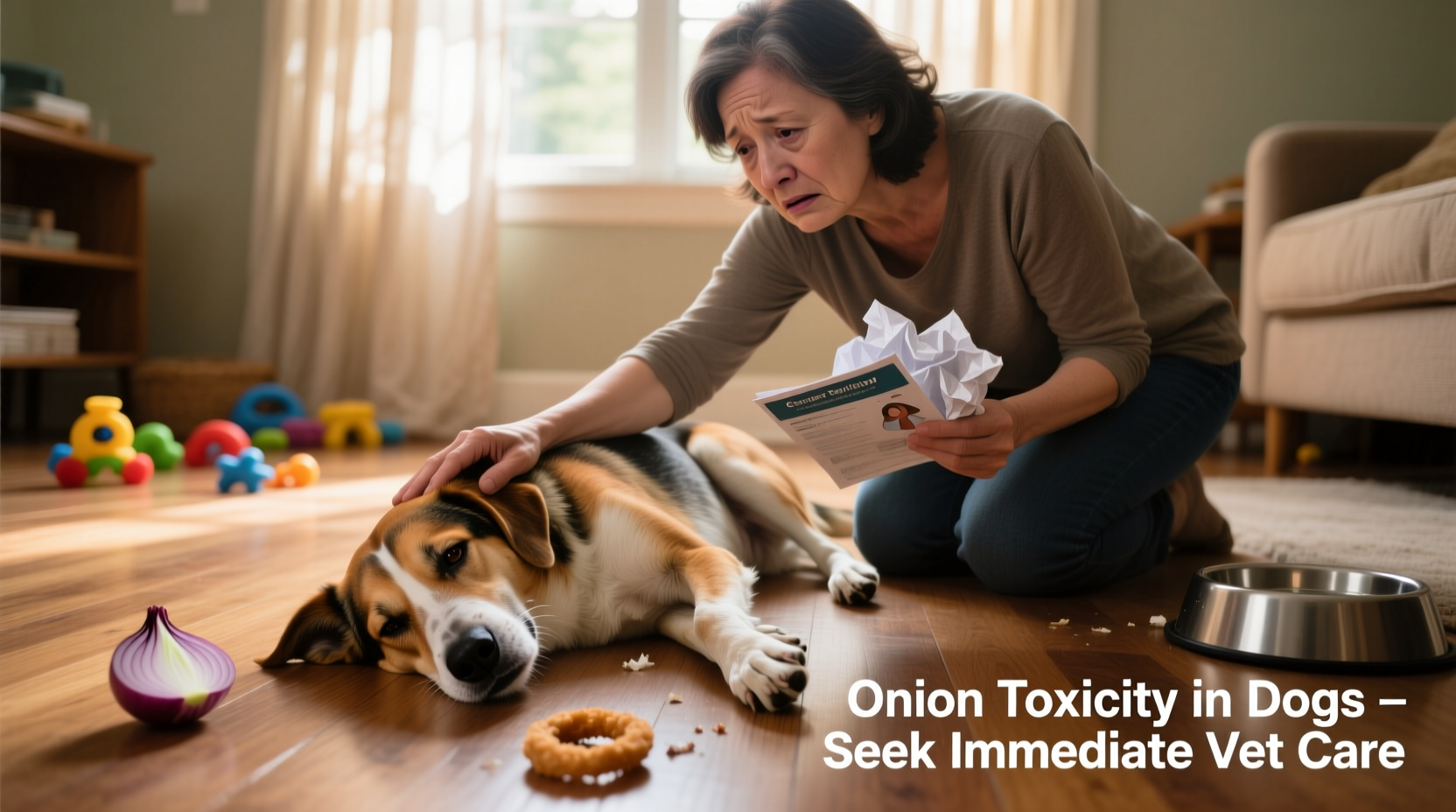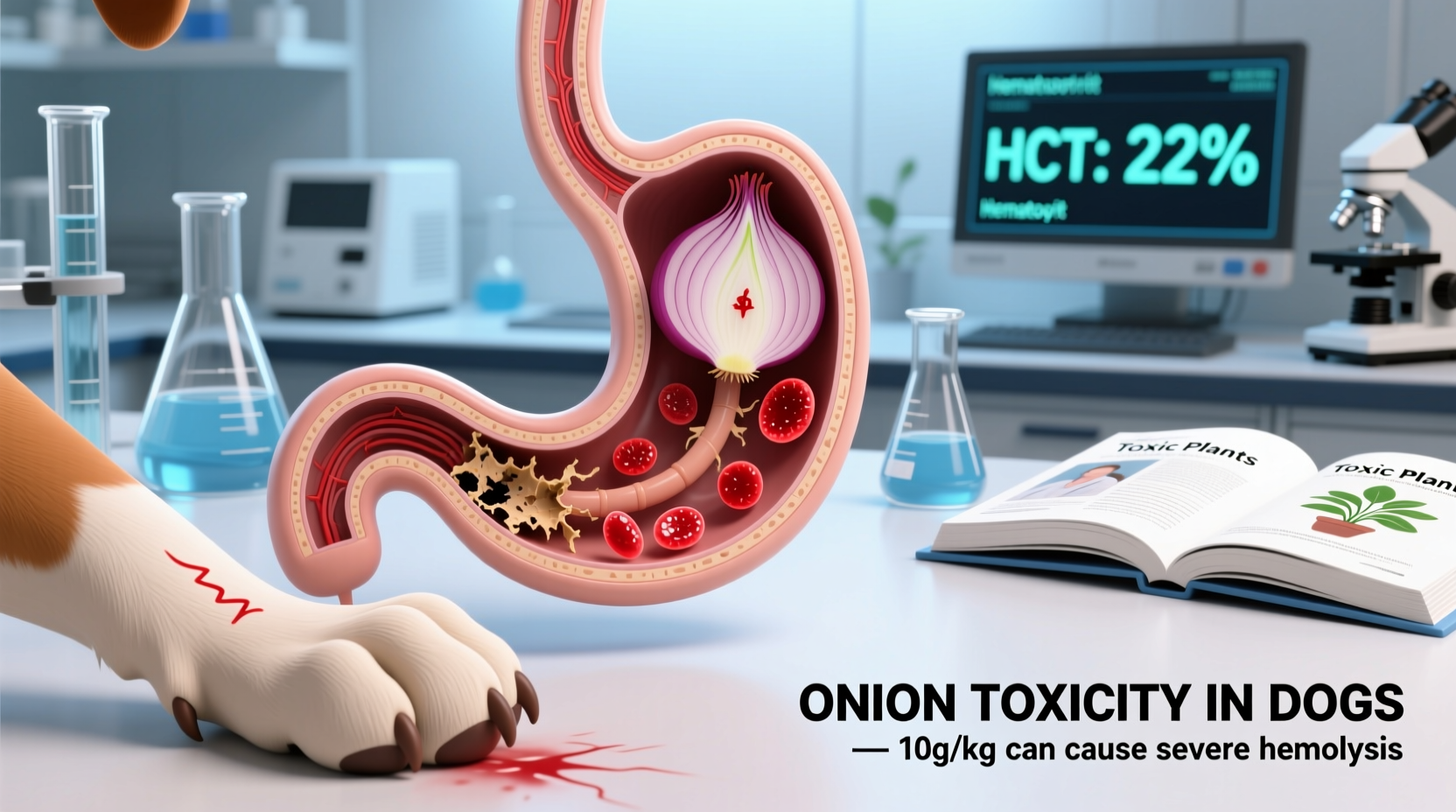Understanding Onion Toxicity in Dogs: A Complete Guide for Pet Owners
When your dog accidentally eats something dangerous, every minute counts. Onion toxicity represents one of the most common yet preventable food poisonings in dogs. Unlike humans who can safely enjoy onions in their meals, dogs lack the enzyme necessary to break down N-propyl disulfide, the toxic compound found in all members of the Allium family including onions, garlic, leeks, and chives.
Why Onions Are Dangerous for Dogs
Onion toxicity occurs when N-propyl disulfide oxidizes hemoglobin in your dog's red blood cells, forming structures called Heinz bodies. These damaged cells become fragile and rupture, leading to hemolytic anemia. The severity depends on both the amount consumed and your dog's size—smaller breeds face greater risk from the same quantity.
| Dog Weight | Dangerous Onion Amount | Equivalent Household Measure |
|---|---|---|
| 10 lbs (4.5 kg) | 68-136 grams | ½ to 1 small onion |
| 30 lbs (13.6 kg) | 204-408 grams | 1½ to 3 small onions |
| 60 lbs (27.2 kg) | 408-816 grams | 3 to 6 small onions |
| 90 lbs (40.8 kg) | 612-1224 grams | 4½ to 9 small onions |
Source: Merck Veterinary Manual, 11th Edition
Symptom Timeline: What to Watch For
Onion toxicity symptoms don't appear immediately—they develop over hours or days as red blood cells continue to rupture. Recognizing this progression can help you seek timely treatment:
- 0-24 hours: Vomiting, diarrhea, abdominal pain, lethargy (early digestive distress)
- 24-72 hours: Pale gums, rapid breathing, increased heart rate (signs of developing anemia)
- 3-5 days: Dark urine (hemoglobinuria), weakness, collapse (severe anemia requiring emergency care)
- 5+ days: Jaundice, organ damage (critical stage requiring intensive treatment)
Smaller dogs and Japanese breeds like Shiba Inus and Akita Inus show heightened sensitivity to onion toxicity due to genetic factors affecting red blood cell stability.
Immediate Action Steps When Your Dog Eats Onions
If your dog consumed onions, follow these vet-recommended steps:
- Document the incident: Note the time, estimated amount, and form (raw, cooked, powder)
- Contact emergency help: Call your veterinarian or ASPCA Animal Poison Control Center immediately
- Do NOT induce vomiting unless specifically instructed—this can cause additional complications
- Bring packaging or food sample: Helps veterinarians determine exact toxic compound concentration
- Monitor vital signs: Check gum color, breathing rate, and energy level while waiting for professional help

Professional Treatment Options
Veterinarians use several approaches to treat onion toxicity depending on exposure timing and symptom severity:
- Early intervention (within 2-4 hours): Activated charcoal administration to prevent further toxin absorption
- Moderate cases: Intravenous fluids to support kidney function and flush toxins
- Severe anemia: Blood transfusions may be necessary when red blood cell count drops below 15%
- Supportive care: Oxygen therapy, anti-nausea medication, and hospitalization for monitoring
According to the American Veterinary Medical Association, dogs treated within 12 hours of ingestion have significantly better outcomes. Delayed treatment increases the risk of permanent organ damage.
Common Misconceptions About Onion Toxicity
Many dog owners operate under dangerous misunderstandings about onion risks:
- "Cooked onions are safe": Cooking doesn't destroy the toxic compounds—onion powder in baby food poses particular risk
- "Small amounts won't hurt": Toxicity is cumulative—repeated small exposures can be as dangerous as one large ingestion
- "Only raw onions are problematic": All forms including dehydrated, powdered, and cooked onions remain toxic
- "Garlic is safe in small doses": Garlic contains higher concentrations of toxic compounds than onions (5x more potent)
Preventing Onion Exposure in Your Home
Protect your dog with these practical prevention strategies:
- Store onions and garlic in closed cabinets away from curious noses
- Dispose of food scraps securely—dogs can detect onion traces in compost bins
- Read pet food labels carefully—some "natural flavorings" contain onion derivatives
- Train family members and visitors about dangerous human foods for dogs
- Use pet-safe alternatives like small amounts of cooked sweet potato for flavor
Remember that onion toxicity can occur through multiple exposure routes—not just direct consumption. Broth-based soups, gravies, and processed foods often contain hidden onion ingredients that pose risks to dogs.
When to Seek Emergency Care
Contact your veterinarian immediately if your dog shows any of these critical symptoms after potential onion exposure:
- Dark red or brown urine (hemoglobinuria)
- Gums that remain pale for more than 2 seconds when pressed
- Rapid breathing (over 35 breaths per minute at rest)
- Weakness or inability to stand
- Unusual lethargy lasting more than 12 hours
Early intervention dramatically improves recovery outcomes. The Veterinary Emergency and Critical Care Society reports that dogs receiving treatment within 24 hours have over 90% survival rates, compared to just 60% when treatment begins after 48 hours.











 浙公网安备
33010002000092号
浙公网安备
33010002000092号 浙B2-20120091-4
浙B2-20120091-4